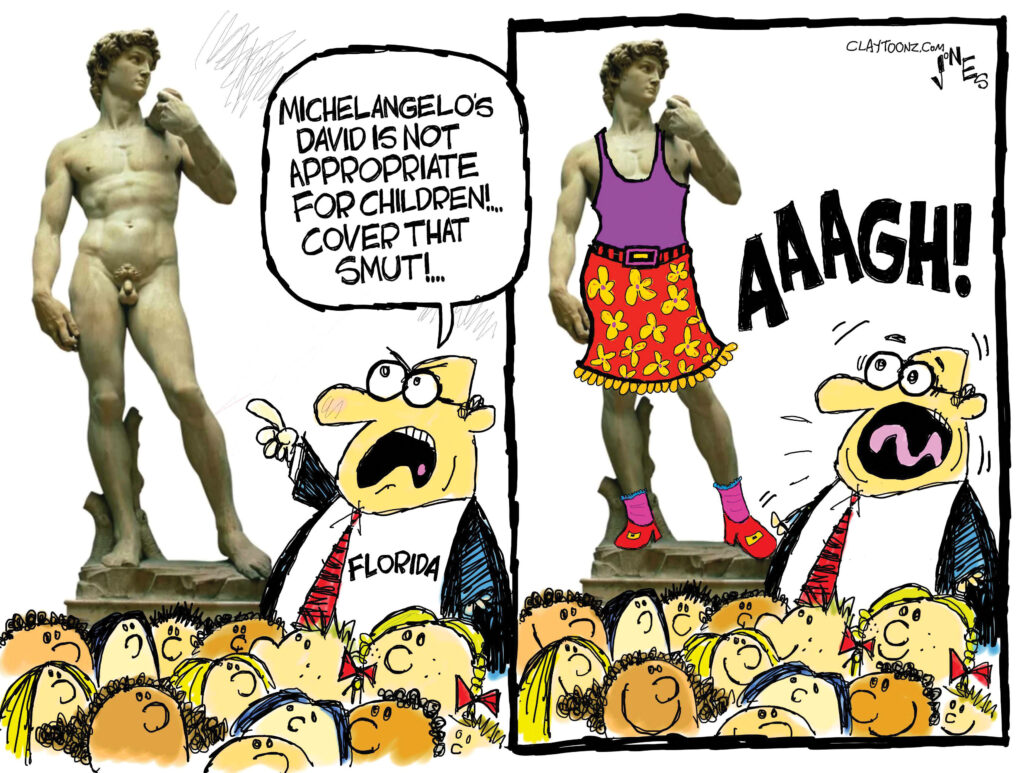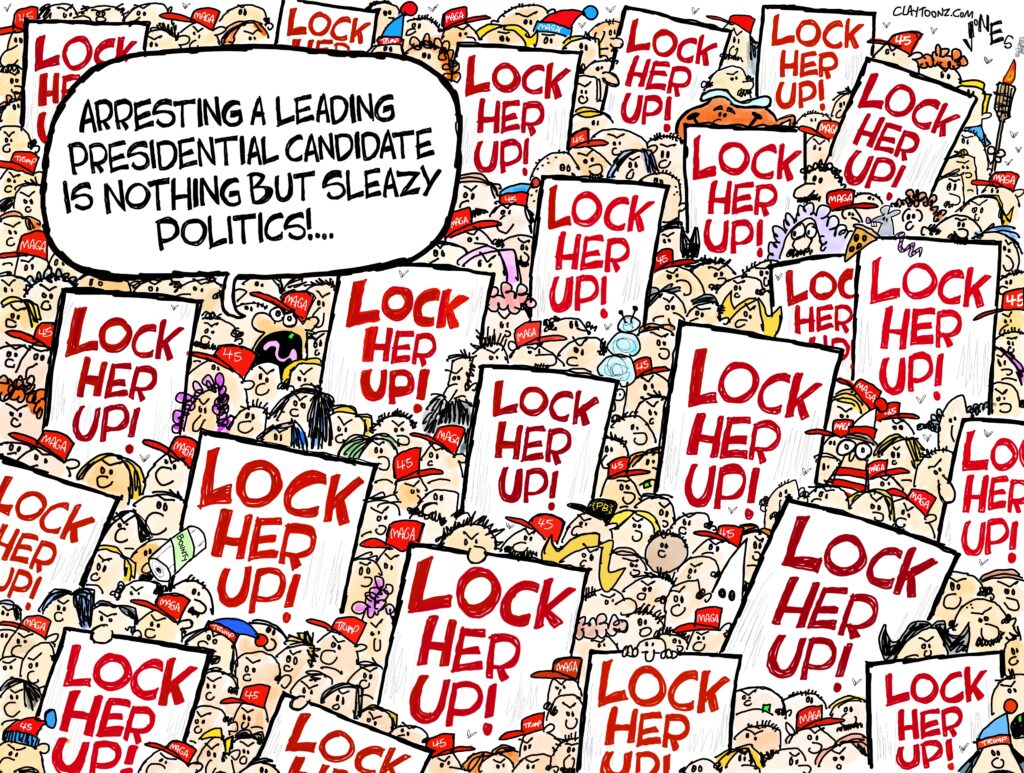In this interview, we are with Clay Jones, an award-winning editorial cartoonist known for his witty and thought-provoking commentary on politics and current events. With over two decades of experience in the field, Jones offers insights into the creative process behind his work, the role of humor in social commentary, and the challenges facing editorial cartoonists in today’s media landscape. Through his engaging and insightful responses, Jones provides a glimpse into the mind of a talented artist and offers valuable advice for aspiring cartoonists looking to make their mark on the world.
Read also: Clay Jones (1966-)
Arifur: What inspired you to become an editorial cartoonist, and how did you start?
Jones: I started drawing political cartoons for a weekly newspaper in Mississippi in 1989. I had always drawn cartoons but hadn’t figured out yet what kind of cartoonist I wanted to be. I never paid attention to editorial cartooning until then, and I realized it had everything I wanted. You can change the subject, layout, and characters from one day to the day. You get to draw on issues that get a quick reaction from readers. And unlike most other types of cartooning, there’s a quick turnaround from drawing to publication.

Arifur: Your cartoons often tackle controversial and sensitive topics. How do you navigate the fine line between humor and offense in your work?
Jones: I don’t worry about offending people because someone’s always going to choose to be offended, especially the type of people and issues my work targets. I just try to be honest with my work. Let the crybabies cry. I don’t think our goal should ever be to offend, but we shouldn’t try to avoid it either. For me, offense is a byproduct of the cartoon and a happy bonus. There’s nothing that makes a Republican MAGA-type person angrier than the truth.
Arifur: How has the field of editorial cartooning changed over the years, and what do you see as the biggest challenges facing cartoonists today?
Jones: The one thing that’s changed is that there are fewer paying publications to publish our work. Fewer editorial cartoonists have jobs today. And the publications that do pay are paying less. Syndication in the United States has catered to this and diminished our value to journalism. At the same time, most news outlets are cowardly and don’t want cartoons that challenge their readers. The most popular cartoons are the ones that don’t say anything. While social media has increased the visibility to our work, social media doesn’t pay the rent. The biggest challenge facing editorial cartooning is our survival.

Arifur: Can you walk us through your creative process, from ideation to final product? How do you come up with your ideas for cartoons?
Jones: After 30 years, I still don’t know how my ideas come to me. I spent the first 20 years of my career training my brain to think like other cartoonists, and then the next ten years untraining it. I think I have conditioned my weird brain to find the weird in every subject. Likewise, I can go through several ideas before I find the one I want. Then I start drawing on my iPad. I keep the digital process as basic as possible, as if I’m still working on paper.
I don’t use a lot of tricks that the iPad allows other than the paint bucket here and there and moving a few things around, like the text. Likewise, I still draw all my lettering by hand. The drawing is usually on one layer and the color is on a second. After it’s completed, I publish it on my blog, social media, send one file to GoComics, and then send three separate files to all of my clients (I’m self syndicated).

Arifur: Your cartoons often feature political figures and commentary. What role do editorial cartoons play in shaping public opinion and discourse?
Jones: I don’t think editorial cartoons shape public opinion, but do play a role in discourse. But nowadays, with politics resembling partisan team sports, most of us are preaching to a choir and living in our own bubbles, which I try to break out of. I love hearing from the other side, even if they’re “offended.” I think too many cartoons follow talking points, especially right-wing cartoonists. Likewise, I think what I originally set out to do when I started my career is still the goal, and that isn’t to change minds as much as it to make readers think. Sometimes, we even inform.
Arifur: You have been vocal about your political views on social media. Is it essential for editorial cartoonists to be politically engaged and outspoken in their personal lives and work?
Jones: Since my work is about politics, I should be engaged and outspoken there. As for my personal life, not so much. I don’t engage strangers in debates, and there are friends and evens family I refuse to discuss politics with. My brain is always turned on for cartoon ideas, but I still need a break. If you talk politics everywhere you are invited, people stop inviting you.

Arifur: Can you describe the relationship between humor and social commentary in your cartoons? How do you use humor to convey profound messages and provoke thought?
Jones: A lot of cartoonists say that editorial cartoons don’t have to be funny, and they’re right. But the cartoonists who live by that are rarely ever funny. Humor is my weapon of choice to get a point across. I like to make readers laugh to express a point, which can also be the hardest thing to do. There’s more truth in humor, which is something the best comedians know. I think using irreverent humor also builds a unique base of readers who remain loyal and anxious for your next cartoon. My readers are almost as weird as I am. Every day, I try to draw the funniest cartoon in the nation. Sometimes, I think I succeed.
Arifur: You have won numerous awards for your work as a cartoonist. How do you stay motivated and continue to innovate in your art, even after achieving such high levels of success?
Jones: That is a challenge and why I intentionally avoid having too much success, so I don’t become too comfortable and lackadaisical. I’m just kidding. The best motivation is being unhappy with the cartoons you’re producing. Looking back at my cartoon at the end of the day and saying to myself, “Ugh!!!! That’s rubbish!” is my best motivator. I do this a lot.

Arifur: What advice would you give aspiring cartoonists interested in pursuing a career in editorial cartooning?
Jones: Get published. Seeing your work in print is the best way to improve your work Maybe you have to draw for exposure at first, instead of money, but make them pay something. Later on, after you’ve become more established, ask for more. Also, listen to advice but always take it for what it is because every cartoonist is different. Keep in mind that when most people give you advice, they’re telling you to do it the way they do it, which may not work for you.
My last piece of advice is: Be weird.
Arifur: Finally, what projects are you currently working on, and what can readers expect to see from you?
Jones: There’s nothing new at the moment other than my regular schedule of daily cartoons, a daily timelapse YouTube video of the cartoon being drawn, a 30-second TikTok video of the cartoon being drawn, and the daily blog. You can also follow me on one of my multiple social media accounts for your daily dose of snark and cynicism.
Arifur: We appreciate your valuable time and for sharing your stories with us.
Explore Claytoonz.com to learn more about Clay Jones and his work.





One Comment